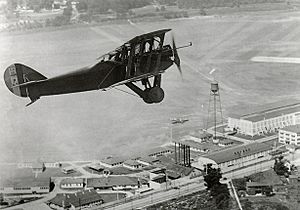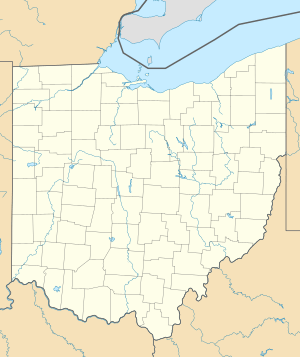McCook Field facts for kids
Quick facts for kids McCook Field |
|
|---|---|
| Dayton, Ohio | |

Major Rudolph W. Schroeder(de) set a 30,900 foot two-man altitude record in a Packard-Le Peré LUSAC-11 Biplane at McCook Field, 24 September 1919
|
|
| Coordinates | 39°46′33″N 84°11′27″W / 39.77583°N 84.19083°W |
| Type | Aircraft Flight Testing |
| Site information | |
| Controlled by | |
| Site history | |
| Built | 1917 |
| In use | 1917–1927 |
| Battles/wars | World War I |
McCook Field was an important airfield and testing center for airplanes in Dayton, Ohio, USA. It was run by the United States Army Air Service from 1917 to 1927. The field was named after Alexander McDowell McCook, a general from the American Civil War. He and his family members were famously known as "The Fighting McCooks".
Contents
History of McCook Field
Building an Aviation Testing Center
In 1917, during World War I, the United States needed many military airplanes. Six business leaders in Dayton, Ohio, including Edward Andrew Deeds, started the Dayton-Wright Company. They built a factory and an airfield in Moraine, Ohio. Deeds also bought land near downtown Dayton for another airfield, which he called North Field.
The United States joined World War I before North Field was fully ready. Deeds then joined the U.S. Army Signal Corps as a colonel. He was in charge of making sure enough aircraft and engines were built for the war. Deeds suggested building a temporary experimental station for aviation. The Army agreed to use North Field, and it opened as McCook Field on December 4, 1917.
McCook Field's Location and Features
McCook Field was located in a flat area near where three rivers met in Dayton. This area is now a park called Kettering Field. The buildings of McCook Field were on land that was once a housing project. Built during World War I, it became the main place for the Army's Engineering Division in 1919.
The airfield had a special runway made of macadam and cinders. Most airfields at that time had bumpy grass runways. However, McCook Field's runway was quite short, about 1,000 feet (300 meters) long at first. It never got longer than 2,000 feet (600 meters). A big sign on the main hangar warned pilots: "THIS FIELD IS SMALL. USE IT ALL." As airplanes got bigger, the field became too small for its important work.
Moving to a New Home
The Army always planned to move McCook Field's operations to a bigger, permanent location. However, leaders in Dayton wanted to keep this important aviation center in their city. John Henry Patterson, who led the NCR Corporation, promised to keep Army aviation in Dayton. He started a campaign to raise money to buy a large piece of land for a new airfield. This land would then be given to the U.S. Army.
Patterson passed away in 1922. His son, Frederick B. Patterson, continued his father's work. He formed the Dayton Air Service Committee. This group of important Dayton citizens and business owners raised $425,000. This money was enough to buy 4,520 acres (18.29 square kilometers) of land east of Dayton. This land included Wilbur Wright Field and the Wright brothers' original flying field at Huffman Prairie. In August 1924, President Calvin Coolidge accepted Dayton's generous gift. This new facility would later become Wright-Patterson Air Force Base.
Helicopter Test Flight
In March 1923, a famous inventor named Thomas Edison sent a message to George de Bothezat. Edison congratulated him on a successful helicopter test flight at McCook Field. Edison wrote that de Bothezat had created "the first successful helicopter." This helicopter stayed in the air for 2 minutes and 45 seconds at a height of 15 feet (4.5 meters).
Closing McCook Field
McCook Field closed when the new Wright Field opened. Starting in March 1927, about 4,500 tons of equipment and materials were moved by truck to the new base. By June 1, 85% of everything had been moved in 1,859 truckloads. On April 1, 1927, McCook Field began to be taken apart. By early 1928, all the buildings were gone.
One of the last flights to McCook Field happened on July 20, 1927. An Atlantic-Fokker C-2 transport plane landed there. On board were Lts. Lester J. Maitland and Albert F. Hegenberger. They had just completed the first flight across the Pacific Ocean to Hawaii in their plane, the Bird of Paradise. They were on a tour, visiting their hometowns and McCook Field, where their flight project had started in 1919.
Key Achievements at McCook Field
McCook Field was a place of many important aviation firsts. Some of the achievements include:
- Developing Aerial application, also known as "Crop Dusting"
- Research into aircraft pressurization, which helps planes fly higher
- Creating better airport service vehicles
- Designing landing lights for aircraft
- Improving the free fall parachute


